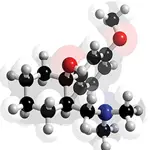Tramadol

Tramadol, a synthetic, centrally acting analgesic agent used to treat acute and chronic moderate pain, may be useful for the treatment of allodynia.1
Indications
Tramadol-mediated analgesia is improved when administered in conjunction with NSAIDs, especially in patients with chronic pain conditions.1,2 Because tramadol is a weak opioid and has a nonopioid mechanism of action, it may be less likely than morphine to induce tolerance.1
Related Artcle: Chronic Pain in Cats with Degenerative Joint Disease
Tramadol can be administered orally or parenterally, but only the oral form is available in the United States. Tramadol is not currently controlled by Drug Enforcement Agency regulations in all regions of the country, but some states are instituting regulatory control. In February 2013, New York recognized tramadol as a Schedule IV drug.

Mechanism of Action & Pharmacokinetics
Tramadol has two synergistic mechanisms of action.1 It acts as a weak mu-receptor agonist and an inhibitor of norepinephrine and serotonin reuptake in the CNS.1 The chemical structure of tramadol is related to those of morphine and codeine. The action on the mu-receptor agonist can be reversed with the opioid antagonist naloxone, which partially reverses the analgesic effect.1
Related Article: Pain Protocols for Common Elective Surgical Procedures
The inhibition of norepinephrine and serotonin reuptake is similar to the major action of many antidepressant drugs and the minor action of a2-agonists.1 Yohimbine, the a-adrenoceptor antagonist, partially reverses the antinociceptive effects of tramadol, which supports the role of the a-adrenoceptors in the antinociceptive effects of tramadol.<sup3 sup>

In humans, tramadol-mediated analgesia is produced primarily by its metabolite, O-desmethyl-tramadol (ODT; ie, M1 metabolite).4 ODT, a high-affinity mu-receptor agonist, is 200 times more potent than tramadol and inhibits serotonin and norepinephrine reuptake.3,5 The metabolite is minimal in dogs and cats after oral administration, and whether these levels are analgesic is not certain.3,6 Plasma ODT concentrations are related to tramadol dose; this is expected because metabolism of tramadol is the only source of ODT.5
Oral dosing in dogs results in rapid absorption with a mean, systemic bioavailability of 65% (± 38%).7 In cats, oral bioavailability is approximately 60%, and peak concentration is reached in 45 minutes.8
Related Article: Management of the Osteoarthritic Canine Patient
Contraindications
Tramadol should not be used with selective serotonin reuptake inhibitors (SSRIs; eg, fluoxetine) or with monoamine oxidase inhibitors (MAOIs; eg, selegiline), as doing so may lead to serotonin syndrome.2 SSRIs can inhibit the metabolism of tramadol and decrease its efficacy.2
Acute overdose of tramadol in dogs or cats may cause CNS depression signs or serotonin syndrome (eg, lethargy, mydriasis, ataxia, vomiting, tachycardia, tremors, vocalization, sedation, agitation, somnolence, hypersalivation, seizures).2 Treatment is supportive. Seizures may be treated with benzodiazepines or barbiturates.2 Naloxone may not help in the treatment of an overdose, as it may increase risk for seizures.2 Tricyclic antidepressants (eg, amitriptyline) may inhibit metabolism and increase risk for seizures.2
Dosing
Tramadol can be administered with or without food1,2 and is readily absorbed, extensively metabolized, and rapidly eliminated in dogs and cats. Because dogs metabolize 99% of tramadol,1 dose adjustments may be needed in dogs with renal or hepatic impairment.2 Optimal dosing of tramadol in dogs and cats will likely require adjustment based on its effects in individual animals.5
Dogs
Tramadol dosing in dogs varies, with suggested doses ranging from 2 to 5 mg/kg q8–12h.2,9 The highest dose for maximum analgesic effect in dogs is 10 mg/kg q8h.2 The dose suggested by the pharmacokinetic profile of tramadol alone in normal dogs is 5 mg/kg q6h or 2.5 mg/kg q4h.7 The dose can be decreased and/or the dosing frequency increased with concurrent use of other analgesic drugs or techniques. Analgesia may not occur immediately and can take up to 14 days when treating chronic conditions (eg, cancer, degenerative joint disease).2
Cats
Tramadol is formulated as a 50-mg unscored tablet, which can make feline dosing difficult.6 To treat cats, tramadol can be compounded as a suspension or a gelatin capsule to provide 2- to 4-mg/kg doses.5 However, compounding pharmacies function under minimal regulation and are not required to prove product efficacy or safety.
The oral dose for the treatment of chronic pain in cats has been suggested at 5 to 10 mg/kg q8–12h.8 The terminal half-life of tramadol in cats is 2.5 hours.6 In cats, doses of 1 to 4 mg/kg q12h are necessary for significant and sustained analgesic effects.2,5 A dose of 4 mg/kg q6h would maintain analgesia close to the maximum effect of tramadol.5
Adverse Effects
Dogs
Because it is a weak opioid, tramadol may result in fewer adverse effects than are typically seen with opioids.6 Some adverse effects may still occur with tramadol use, especially with long-term administration. In dogs, constipation or diarrhea can occur.1 Inappetence, vomiting, excess sedation, agitation, anxiety, tremors, and dizziness have also been reported.2 In a recent study in greyhounds, however, tramadol caused no vomiting, diarrhea, or agitation.3

Cats
In cats, dose-dependent opioid-like effects (eg, dilated pupils, euphoria [excessive playfulness, kneading, friendliness]) can occur.8 Cats may develop mydriasis, sedation, excessive salivation, vomiting, dysphoria, and facial itch (evidenced by facial scratching and rubbing).2,5
Cost
Tramadol is a relatively inexpensive generic drug. A human tramadol product is available (Ultracet, janssenpharmaceuticalsinc.com) but should not be used in cats, as it contains acetaminophen. Acetaminophen is used in dogs, although it has not been FDA approved.
JANE E. QUANDT, DVM, MS, DACVAA, DACVECC, is associate professor of small animal medicine at University of Georgia. Her professional interests include anesthesia for trauma and shock patients. She lectured at the NAVC Conference in 2013. Dr. Quandt completed an anesthesia residency and master’s degree at University of Minnesota and earned her DVM from Iowa State University.